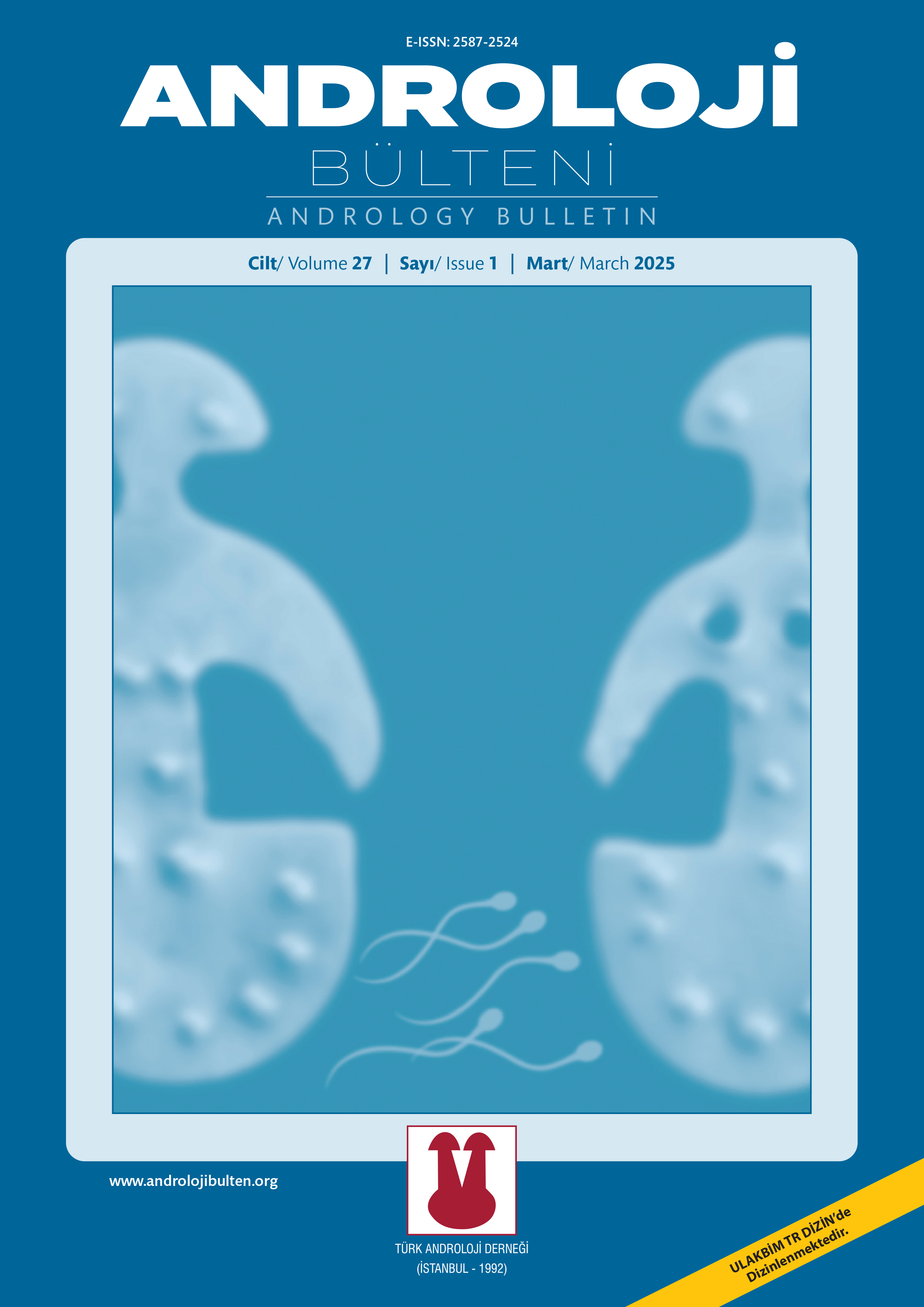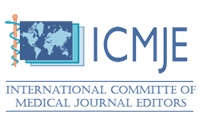INDEXES

Content of this journal is licensed under a Creative Commons Attribution-NonCommercial 4.0 International License.
Volume: 25 Issue: 1 - 2023
| 1. | Cover Page I |
| 2. | Reviewers Pages II - III |
| 3. | From the President Page IV |
| 4. | From the Editor Page V |
| 5. | Contents Page VI |
| ORIGINAL ARTICLE | |
| 6. | Our results of dorsal slit method in children applied with circumcision Kenan Yalçın doi: 10.24898/tandro.2023.34445 Pages 1 - 5 OBJECTIVE: Circumcision, one of the oldest known surgical procedures in the history of humanity, is still being applied in many different techniques over the centuries in connection with its increased knowledge. In this retrospective study, we aimed to discuss the results of the Dorsal Slit method. MATRERIAL and METHODS: Between June 2011 and July 2022, 5122 cases who were circumcised using the dorsal slit technique were reviewed retrospectively. Of the cases the mean age, duration of surgery and surgical intervention results were evaluated. RESULTS: The mean age of the patients included in the study was 4.82±3.18 years. The mean procedure time was calculated as 11.74±2.04 minutes. Complications were observed in 20 (0.39%) patients due to anesthesia and 39 (0.78%) patients due to surgical intervention. No complications that could cause mortality or morbidity were encountered. No patient underwent a second surgical intervention due to complications. CONCLUSION: In children who underwent circumcision, the Dorsal slit method is a successful surgical procedure with low complication rates. |
| 7. | Efficacy and safety of daily tadalafil and sertraline combination therapy in heterosexual patients presenting with erectile dysfunction and concomitant premature ejaculation Kemal Ertaş, Abdullah Akkurt, Zülfü Sertkaya doi: 10.24898/tandro.2023.04379 Pages 6 - 10 OBJECTIVE: The aim of this study was to evaluate the efficacy and safety of daily tadalafil 5 mg and sertraline 50 mg treatment in 3-month follow-up in patients presenting with erectile dysfunction (ED) complaints and accompanying premature ejaculation (PE) symptoms. MATRERIAL and METHODS: This prospective, observational single-arm study was conducted between March and September 2021 among patients suffering from ED and concomitant Lifetime/acquired PE. The Turkish validity of the International Erectile Function-Erectile Function Index (IIEF-EF) was used for the diagnosis of ED in the patients. The patients filled the Premature Ejaculation Diagnostic Tool (PEDT) questionnaire for the diagnosis of PE. Additionally, the Premature Ejaculation Profile (PEP) score was filled. A detailed medical history was taken from all patients and a complete physical examination was performed. After a fourweek follow-up period, patients were given 5 mg tadalafil and sertraline 50 mg tablets daily. The IELT durations of the patients were recorded after 12 weeks of treatment. Premature ejaculation profile and IIEF-EF questionnaires administered to the patients at the beginning were filled again. In addition, the Global Impression of Change (GIC) questionnaire was applied in terms of treatment satisfaction. RESULTS: A total of 71 patients were included in the study. Sixty-three patients completed the study (88.73%). As a result of 3-month daily tadalafil 5 mg + sertraline 50 mg combination therapy, the geometric mean IELT, PEP index scores and subgroup scores of the patients improved and a statistically significant increase in the IIEF-EF scores (p<0.001). In addition, considering the GIC questionnaire, 81.69% (58/71) of the patients stated that they were satisfied with the treatment. CONCLUSION: In conclusion, daily administration of tadalafil and sertraline provides an effective and reliable objective and subjective improvement in the management of patients with ED and accompanying PE. |
| 8. | How did lock-down due to COVID-19 pandemia effect sexual life of Turkish women? A cross sectional survey study Adil Emrah Sonbahar, Özlem Geyik doi: 10.24898/tandro.2023.68542 Pages 11 - 17 OBJECTIVE: To evaluate the sexual behavior of women after the lockdown that was implemented for three months during the COVID-19 pandemic. MATRERIAL and METHODS: This observational study was conducted between July-August 2020. Participants received an informed voluntary consent form and questionnaire via email, as well as via Twitter, LinkedIn, Instagram, and WhatsApp social media platforms on the Internet. Demographic characteristics of the participants were recorded. Whether the participants wanted to have a child during the pandemic, the birth control method they used, and the frequency of sexual intercourse (increase/decrease) during lock-in were evaluated, and sexual function was examined with the Female Sexual Function Index (FSFI). RESULTS: A total of 1055 patients were included in the study. Patients’ mean age was 30.2±4.3 years (20–45 years). Most were married (n=1037, 98.3%). The percentage of those who wanted to have children during the pandemic was 26.6%(n=281). More than half did not use any contraceptive (52.3%, n=552). The most common method of contraception was condom use (n=370). The mean FSFI total score was 23.79±7.81(2–34.90). Statistically, sexual dysfunction was rather found to be the participants who were older than 30 years (p=0.003), who had high school and lower educational background (p=0.004), and those reporting that the frequency of sexual intercourse in the pandemic has decreased (p<0.001). CONCLUSION: We observed a reduction in the frequency of sexual intercourse of women and their sexual function has been affected during the COVID-19 pandemic. This impact has been determined to depend on age, level of educational background, sharing the same house with the partner, and frequency of sexual intercourse. |
| 9. | Evaluation of pregnant women’s attitudes towards sex life and sexuali Esra Güney, Zeynep Bal doi: 10.24898/tandro.2023.27167 Pages 18 - 26 OBJECTIVE: This study was conducted to evaluate the attitudes of pregnant women towards sexual life and sexuality. MATRERIAL and METHODS: The cross-sectional study was conducted between 30 April and 30 May 2022. A total of 298 healthy pregnant women aged 18 years and older were included in the study. Personal Information Form and Attitude Scale toward Sexuality during Pregnancy (AStSdP) were used to collect data. RESULTS: In the study, 50.7% (n=151) of the pregnant women exhibited a positive attitude towards sexuality, and the total mean scores of the total and sub-dimensions of AStSdP were 112.36±14.21, 28.17±6.17, 38.13±6, respectively..66 and 46.06±7.06. In addition, it was determined that the total mean score of AStSdP was higher in pregnant women who were ≤29 years old, had ≥ university-level education, had health insurance, had a good income, and had a marriage period of 1–5 years (p<0.05). CONCLUSION: During the preconceptional period and while giving prenatal care by health professionals, the issues that women misunderstood or misunderstood should be clearly stated, and education and counselling should be provided about sexuality. |
| 10. | How quality and reliable are youtube videos about hydrocele for patients? Berk Yasin Ekenci, Hilmi Sarı doi: 10.24898/tandro.2023.75010 Pages 27 - 31 OBJECTIVE: In this study, our aim is to evaluate the adequacy, quality and reliability of the Turkish video contents found on YouTube about hydrocele disease. MATRERIAL and METHODS: In order to find videos about hydrocele disease, the term ‘Hydrocele’ was written in the Youtube search section on February 14, 2023. Videos in the last five years to make videos up to date were included in the study. The first 50 video content determined after the exclusion criteria was included in the study. The video quality included in the study data is described by ‘Global Quality Scale’ and video reliability is defined by modified ‘DISCERN’ scales. RESULTS: A total of 50 videos related to hydrocele on YouTube were analyzed. The total number of views included in the study was 384.290. In 48 (96%) of 50 videos, he was a doctor who had information or surgery on hydrocele disease. The average ‘Global Quality Scale’ of the videos prepared for hydrocele disease was measured as 2.3±1.06 points. For patients, very useful, full and clear information, ‘Global Quality Scale’ score of five videos could not be detected (0%). The average score of the modified DISCERN scale was 2.06±0.95. Since no video is based on the sources and did not propose additional sources of information for patients, the modified DISCERN scale score was not found (0%). CONCLUSION: Health information about health is increasing day by day. In today’s age, patient information requests can be met instantly via the Internet. Doctors and related associations should be aware of this situation in order not to be misinformed and misleaded by patients. For this reason, it is important to take the right |
| REVIEW | |
| 11. | Evaluation of erectile dysfunction after minimally invasive surgical treatment in prostate cancer with current literature Enis Mert Yorulmaz, Yigit Akın doi: 10.24898/tandro.2023.62134 Pages 32 - 33 Prostate cancer is among the most frequently diagnosed cancers in men; Its prevalence is increasing gradually as a result of developing diagnostic methods. There are also new treatment methods that follow the developing diagnostic methods. The most common complication after prostate cancer treatment is erectile dysfunction. With the decrease in the age of diagnosis, this complication is more important and is being discussed today. In this review, we will present the effect of minimally invasive surgical treatments applied in prostate cancer on erectile function in the light of current literature. |
| 12. | Sexual function after urethroplasty – affecting factors and precautions Emre Tokuç, Metin İshak Öztürk doi: 10.24898/tandro.2023.14880 Pages 34 - 39 Success in urethral surgeries is generally evaluated by the patency of the urethra and the strength of the urine flow rate. However, from a different perspective, sexual complications that may occur after urethroplasty can seriously reduce the quality of life of patients and change the perception of operative success. It is critical to address these concerns in preoperative counseling for patients with urethral stricture and to follow up with them postoperatively. In this review, the sexual dysfunctions that may be encountered after urethroplasty, the factors affecting them, and the precautions that can be taken are mentioned. |
| 13. | Factors affecting reproductive health in women with disabilities, reproductive health problems and the role of the nurse Esra Güler, Nülüfer Erbil doi: 10.24898/tandro.2023.32848 Pages 40 - 48 Approximately15% of the world’s population lives with a physical, sensory, intellectual or mental disability, and 80% of these disabled individuals are in low– and middle-income countries. Women with disabilities are the group with the greatest difficulty in accessing and using information and services related to their sexual and reproductive health rights, which are the right of everyone around the world. The vast majority of women with disabilities do not have a say in sexual and reproductive health, they are accepted as genderless, they are evaluated as if they do not have reproductive rights, and they face obstacles. Factors such as people’s perceptions of disability, inaccessible health care facilities and equipment, discrimination, transportation barriers to accessing facilities, economic inadequacy, negative treatment from staff, unequal allocation of time and money within the household for their care prevent women from seeking, using and accessing health care. The barriers faced by women with disabilities in accessing reproductive health services can be grouped as national barriers related to the health system and individual barriers related to psychological, behavioral, social, physical, economic and education. Attention is drawn to issues such as education and care in reproductive health problems of disabled women, menstrual cycle and hygiene behaviors, sexual life, gynecological examination, family planning, parenting and fertility, sexually contagious infections. Among the health personnel, nurses are at a key point in solving the reproductive health problems of women with disabilities. For this reason, while giving care to disabled women, they should provide ethical and holistic care within the needs of disabled people, away from prejudice. In this review, it is aimed to guide in which areas women with disabilities have problems, the factors affecting them, and the nursing approaches developed for these problems. |
| 14. | Effect of COVID-19 pandemic and COVID-19 vaccine on menstrual cycle Fatma Yıldırım, Hüsne Yücesoy, Nuriye Büyükkayacı Duman doi: 10.24898/tandro.2023.58826 Pages 49 - 52 Menstrual cycle irregularities include changes in menstrual cycle frequency, regularity, duration or intensity, as well as breakthrough bleeding. The global prevalence of irregular menstrual cycle ranges from 5% to 34% during reproductive years, and related problems constitute one of the most common reasons for referral to a gynecologist. It has been stated that during the Covid-19 pandemic and after the covid-19 vaccines, menstrual irregularities increased and the number of pads decreased in women. If these changes are related to the vaccine, it is thought that it may be a result of the immune response to the vaccine rather than a specific vaccine component. While reported changes in menstrual cycle after vaccination are short-lived, robust research on this potential adverse reaction remains critical to the overall success of the vaccination program. While Covid-19 affects social life, women cause hormonal imbalances, especially during the sexually active period. As a result, menstrual cycle irregularities may result in a decrease in the number of pads used and result in a decrease in the number of population that will threaten future generations. The aim of this study was to investigate the effects of mRNA vaccine and adenovirus vectored vaccines developed as Covid-19 pandemic and Covid-19 vaccine between December 2019–2022, the beginning of the pandemic process, on hormonal disorders and menstrual cycle irregularities. Resources were accessed from the literatures PUBmed, Web of Science, Google Academic using the keywords “Covid-19 pandemic, Covid-19 vaccine, menstruation, menstrual cycle irregularity” and 14400 references were identified. The number of retrospective studies and case reports were excluded, and the number decreased to 30, and 20 of the appropriate scientific publications were included in the study by scanning the rest. |
| 15. | Current approaches to penis enlargement treatment Yaşar Başağa, Zülfü Sertkaya doi: 10.24898/tandro.2023.32704 Pages 53 - 58 Penis size is shaped by genetics, nutrition, hormones, and environmental factors. As an element of interaction between couples involving many factors, it has been the subject of discussion from the past to the present and has been closely associated with sexual satisfaction. Having a larger penis has been associated with a better sex life, affecting men’s self-confidence. Various treatment methods have been developed in the field of penis enlargement due to these approaches which can affect the perception of not only men but also women and some medical conditions. Invasive and non-invasive techniques are summarized in this review. |
| CASE REPORT | |
| 16. | Penile fracture with complete urethral rupture Osman Çağatay Çiftçi, Ercan Ogreden, Doğan Sabri Tok, Mehmet Karadayı, Ural Oğuz, Erhan Demirelli doi: 10.24898/tandro.2023.05925 Pages 59 - 62 OBJECTIVES: Penile fracture is a trauma that develops as a result of the rupture of the corpus cavernosum by forcing the erect penis to bend and twist and requires emergency surgery. Urethral trauma accompanies penile fracture in 1–40% of cases. In this study, we aimed to present a case of penile fracture with complete urethral rupture. CASE REPORT: A 51-year-old male patient presented to the emergency service with the complaints of sudden loss of erection, bruising and pain in the penile shaft after a cracking sound during coitus. Physical examination revealed limited ecchymosis and swelling in the penile shaft and hemorrhage in the external urethral meatus. Urethrography was performed on the patient due to urethrography. On urethrography, it was observed that there was contrast extravasation from the middle urethra. The patient was operated in the early period. In the midpenile region, it was observed that there were ruptures of approximately 1 cm in both corpus cavernosum and complete rupture in the urethra. Cavernosal ruptures and urethral rupture were repaired. At the postoperative 6th month follow-up, the patient had no erectile dysfunction and voiding symptoms. CONCLUSIONS: The “crackling sound” heard during coitus, severe pain and penile detumescence are typical clinical findings of penile fracture. If there are symptoms of bleeding in the meatus, hematuria and difficulty in voiding, urethral trauma should be considered. In these patients, urethral repair is also required during the operation. |
| PUBLICATIONS AND CONGRESS CALENDAR OF ANDROLOGY | |
| 17. | Publications and Congress Calendar of Andrology Pages 63 - 66 Abstract | |














